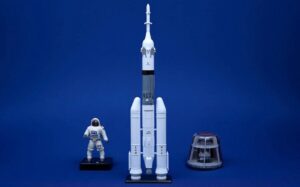The Americans have Astronauts and the Russians the cosmonauts. Indians will have their Vyomanauts when Gaganyaan is launched, soon. The word has its origin in Sanskrit vyoman meaning endless sky or space and it roughly translates to one who travels in space.ISRO’s Gaganyaan project is probably the most challenging as it involves human lives.
The project envisages a demonstration of India’s human space flight capability where 3 crew members will be launched to a Low Earth Orbit (LEO) of 400 km for a 3-day mission and will be brought back safely to Earth by landing in Indian sea waters.
The basic prerequisites for a man mission to space are, i) a powerful rocket, ii) a crew module, iii) a space suit, iv) a life support system, and v) Training. The LVM3 launch vehicle of ISRO will be used to carry Gaganyaan to its designated orbit in space. It is a three-stage launch vehicle with solid, liquid, and cryogenic propellants. Many of us have seen a launch vehicle on our TV screens before its launch from Sriharikota. What do we see? We see a vertically standing rocket narrowing at the top and two strap-on motors on the sides. While the main rocket body contains the liquid and cryogenic propellants and the payload, the strap-on contains solid fuel ignited one after the other starting from solid to liquid and finally to cryogenic in the last stage to put the payload in the orbit.
In Gaganyaan LVM3 will be re-configured to meet human rating requirements like providing the Crew Escape System, both at low and high altitudes, and other navigational support. This system will be attached to the nose cone at its top, in case Vyomanauts need to be ejected from the launch vehicle to sea due to any emergency. After the modification, this launch vehicle will be called HLVM3.
The second requirement is a Crew Module (CM) that will carry Vyomanauts to space. The CM will have two parts, an upper Crew Module and a lower Service Module (SM); together they are called Orbital Module. The CM will have a habitable space with an Earth-like environment with a double-walled design that is, an inner pressurized metallic structure and an external unpressurized structure with a Thermal Protection System(TPS).
The SM is a support system to CM while it is orbiting the Earth and will house various systems including thermal, propulsion, power, avionics, and deployment mechanisms. For other requirements like space suits, life support system, and training of Vyomanauts, ISRO is coordinating with Indian industry, seeking intellectual support from academia and research institutions along with cutting-edge technologies available with international agencies.

The sequence of events of Gaganyaan’sjourney from launch to safe splash in the Arabian Sea would be, 1) After the launch from Sriharikota, it will take 16 minutes to reach the 400 km orbit, 2) The spacecraft will orbit the Earth for 3-5 days, as per the final plan. While orbiting Vyomanauts will conduct microgravity experiments, 3) After the scheduled stay in space, the CM will separate from the SM. The separated CM will then realign and reorient to re-enter Earth’s atmosphere at an angle that will have minimal friction, 4) Initially, the CM will have a faster free fall.
To slow it down parachutes on board will be deployed and 5) Safe splash down in the Arabian Sea, near Gujarat coast by deploying the Flotation system so that the CM floats on the surface and can be identified and recovered by the Indian Navy.
The most crucial phase will be the re-entry of the CM in Earth’s atmosphere from near vacuum conditions with high speed that creates high friction generating high temperatures on the module. That is why realignment and reorientation of CM for which it is appropriately designed is very critical to reduce the drag during the re-entry phase. Though enough protection in the form of layers of Heat Shield made of silica and carbon composite materials are provided the Vyomanauts will have to endure extreme heat combined with shock waves generated during the re-entry phase that will last for 36 minutes till its final splash in the sea.
Scientists are dreamers and a country progresses on their shoulders when their dreams get fructified into new technologies that are beneficial to mankind, in general, and to the needs of the country and society, in particular. The support of the government of the day in terms of autonomy and generous funding is crucial to realising these dreams. ISRO is an organization where passion-driven scientists work day and night and work on projects that are ahead of time.
The man mission to space started taking shape in ISRO at the turn of the 21st century. In 2004, it prepared a vision document for a Human Spaceflight Program (HSP) followed by preliminary studies and technological development of a Gaganyaan under the generic name Orbital Vehicle. The success of the Space Capsule Recovery Experiment (SRE-1) in 2007 provided the impetus required for embarking on a journey that would soon become a reality after one and a half decades.
The design of the CM was finalized as early as March 2008 and ambitious target dates were announced for the launch of a man mission to space. I vividly remember the four-day Space Expo 2010 organized by ISRO and the Confederation of Indian Industry (CII) at Bengaluru where samples of dried and packaged food for astronauts developed by a Mysore-based laboratory were displayed.
But for some unknown reasons, the work on Orbital Vehicle slowed down in later years. Maybe the priorities at ISRO changed as Mangalyaanand Chandrayaan missions were in full swing at that time which necessitated funds re-allocations. The situation changed with the success of both the Chandrayaan-1 and Mangalyaan missions. In 2014 ISRO undertook an uncrewed test launch of the CM aboard the GSLV Mk3 X1 experimental sub-orbital flight and demonstrated successfully its re-entry and splash down in the Bay of Bengal. In a parallel development, a Gujarat-based firm developed a prototype of a flight suit (Intra-Vehicular Activity suit or IVA suit-a kind of spacesuit).
Another important event was the successful demonstration of the Re-Usable Launch Vehicle Technology Demonstrator (RLV-TD) that will eventually be used in future manned missions. The most critical of the technology demonstrator was in 2018 when ISRO conducted a critical crew bailout test or ISRO Pad abort test to see how fast and effectively the CM could be released safely in the event of an emergency.
Buoyed by the series of successes with indigenous space technologies, Prime Minister Narendra Modi announced in his 2018 Independence Day speech that the Indian Human Spaceflight Mission will be undertaken by 2022, the 75th anniversary of the independence of the country. But, Covid-19 affected the progress of the project and delayed it by a couple of years.
Jitendra Singh, Minister of State for Space, Science and Technology announced recently that ISRO will conduct the first test flight of the Gaganyaan mission on 21 October, 2023. The purpose of this test flight will be to check the efficacy of the CM to outer space and bring it back to earth and recover it after the splash in the Bay of Bengal. The march has begun and the destination is not far. The country awaits the moment when our Vyomanauts undertake a space journey and arrive back safely to the Gujarat coast. (The author is a former Chief Scientist at CSIR-NGRI, Hyderabad)






